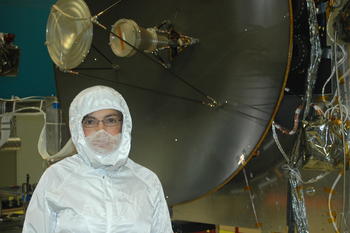Sandra Cauffman was sitting in a neighbor’s living room on July 20, 1969, watching along with millions around the world as astronauts took humanity’s first steps on the moon. Like thousands of other children that day, she turned to her mother and declared that one day, she too wanted to walk on the moon’s cratered surfaces. What young Sandra didn’t yet understand was that, as a poor girl in Costa Rica being raised by a single mother, her dream of one day being part of the U.S. space program was, at the time, seemingly even more distant than the moon itself.
“Sometimes parents try to insert a little realism, so their kids don't dream too big,” Sandra said. “But instead of saying, ‘Well, we’re from Costa Rica and that's the United States,’ or ‘we're poor, and you are a woman’…my mom never said any of that. She just told me, ‘Put you mind to it and study hard. You never know!’”

Motivated by her mother’s unwavering belief, Sandra graduated second in her class and enrolled in the University of Costa Rica, studying industrial engineering for three and half years. But something was missing; her passion for space remained unfulfilled. Around that time, her mother married a kind and supportive man from Northern Virginia. Recognizing Sandra’s frustration, her new father offered her the opportunity to facilitate a visa for her to come to the United States to study and live in his home in Manassas. Sandra said that he told her, “’I know you’re not happy in school. I can’t pay for you to go to college in the U.S., but if you can get a job and figure out a way to make it work, you can live there and go to university.’”
With no English skills and just determination in her suitcase, Sandra arrived in Virginia and found work at the now-closed Scott’s hardware store. She set out to learn the language and, soon after, enrolled in an English class at George Mason University. “I had to learn English really fast, and I finally took the TOEFL (test of English as a foreign language) …and I passed by just one point! That’s how I was able to start at Mason in the fall of 1984.”
She majored in electrical engineering and, along the way, decided to also pursue physics, a decision that would prove important both personally and professionally. One day in a calculus class, a tall young man from the physics program sat in front of her. His name was Stephen and after being friends for a few years, they began dating two months before graduating in December 1987. They married in September of 1988 and went on to build a family together, raising two sons, Stephen (33) and Ryan (29).
Although Sandra never made it to the moon, she achieved the next-best thing, in her eyes: she built a remarkable career at NASA. Today, with more than 35 years of service, she is the Deputy Director of the Astrophysics Division in the Science Mission Directorate. Her achievements include the NASA Exceptional Achievement Medal, three NASA Outstanding Leadership Medal, and four Acquisition Improvement Awards.
She credits George Mason University with helping her reach those celestial heights. “I was surrounded by people like me, people who came from elsewhere, who were working hard, learning English and focused on getting their degrees. We supported each other.” She remains deeply connected to her alma mater and gives back, including serving as a keynote speaker at the 2025 Volgenau School of Engineering’s Degree Celebration.
She holds a BS in Physics, a BS in Electrical Engineering and a MS in Electrical Engineering, all from George Mason University. In 2018, the university honored Cauffman achievements at their 50th Anniversary as one of the 50 “exemplars”--alumni who exemplify the global impact of a George Mason education.
Turns out, you don’t need moon boots to make giant leaps.
